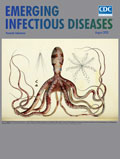
Volume 26, Number 8—August 2020
Dispatch
Evolution and Antigenic Drift of Influenza A (H7N9) Viruses, China, 2017–2019
Jiahao Zhang1, Hejia Ye1, Huanan Li1, Kaixiong Ma, Weihong Qiu, Yiqun Chen, Ziwen Qiu, Bo Li, Weixin Jia, Zhaoping Liang, Ming Liao , and Wenbao Qi
, and Wenbao Qi
Abstract
After a sharp decrease of influenza A(H7N9) virus in China in 2018, highly pathogenic H7N9 viruses re-emerged in 2019. These H7N9 variants exhibited a new predominant subclade and had been cocirculating at a low level in eastern and northeastern China. Several immune escape mutations and antigenic drift were observed in H7N9 variants.
Since emerging in China in 2013, influenza A(H7N9) viruses have continued to circulate in mainland China, sporadically causing human infection (1–3). As of February 2020, a total of 1,568 laboratory-confirmed human cases and 616 related deaths had been reported, for a fatality rate of ≈40% (). In mid-2016, a highly pathogenic avian influenza (HPAI) virus of subtype H7N9 emerged, and the number of cases in humans began to rise sharply during a fifth wave (4,5). Animal studies indicated that these HPAI H7N9 viruses are highly virulent in chickens and have gained transmissibility among ferrets (5–7). Also, the cocirculation of HPAI (H7N9) viruses caused high genetic diversity and host adaption (8), posing public health concerns.
Although HPAI H7N9 viruses spread widely across China in 2017 (8,9), after an influenza H5/H7 bivalent vaccine for poultry was introduced in September 2017, the prevalence of the H7N9 viruses in birds and humans decreased dramatically (6,10). In early 2019, when the novel HPAI H7N9 viruses re-emerged, the isolation of HPAI H7N9 viruses from birds revealed them to be responsible for continuous epidemics in northeastern China (11). In March 2019, a human death in Gansu, China, was confirmed to have been caused by an H7N9 virus (12). To explore the prevalence and evolution of influenza A(H7N9) viruses, we sequenced 28 hemagglutinin (HA) and neuraminidase (NA) genes of poultry-origin H7N9 viruses circulating in China during 2019.






















.png)











No hay comentarios:
Publicar un comentario